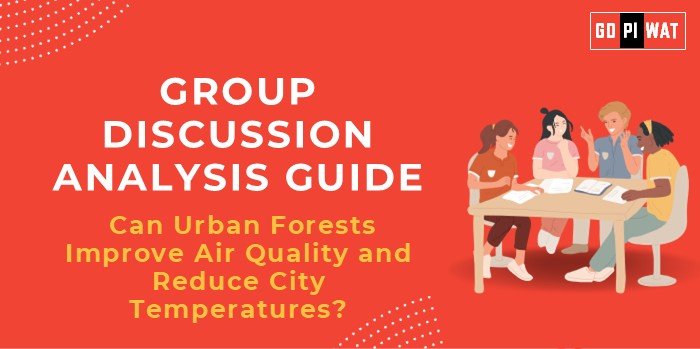📋 Group Discussion Analysis Guide: Can Urban Forests Improve Air Quality and Reduce City Temperatures?
🌳 Introduction to the Topic
Opening Context: With rapid urbanization, cities face escalating challenges like air pollution and urban heat islands (UHIs). Urban forests emerge as a promising solution, blending environmental sustainability with urban planning to mitigate these issues.
Topic Background: Urban forests involve the strategic planting and management of trees and green spaces within cities. By improving air quality and moderating city temperatures, they enhance urban livability. Globally, initiatives like New York’s Million Trees NYC and Singapore’s City in Nature show their transformative potential.
📊 Quick Facts and Key Statistics
- Air Pollution Impact: Cities contribute 75% of global CO₂ emissions, with particulate matter (PM2.5) levels often exceeding WHO standards.
- Cooling Effect: Urban forests can lower city temperatures by up to 7°C through shade and evapotranspiration.
- Carbon Sequestration: A mature tree absorbs approximately 22 kg of CO₂ annually.
- Green Coverage Goals: India aims for 33% forest and tree cover under its Green India Mission.
🤝 Stakeholders and Their Roles
- Government Agencies: Develop urban forestry policies and fund initiatives.
- Environmental NGOs: Advocate for sustainable urban planning and community involvement.
- Citizens: Participate in tree planting and maintenance.
- Urban Planners: Integrate green spaces into city design for long-term impact.
- International Organizations: Provide technical and financial support for urban greening projects.
🏆 Achievements and Challenges
Achievements
- Pollution Control: Urban forests reduce PM10 by up to 60% in dense urban areas.
- Climate Resilience: Cities with green corridors experience lower heatwave mortality rates.
- Social Benefits: Increased green cover improves mental health and fosters community cohesion.
- Global Success Stories: Singapore’s urban greening efforts reduced its average urban temperature by 2-3°C.
Challenges
- Space Constraints: Limited land availability in dense urban areas.
- High Maintenance Costs: Ensuring tree health and sustainability over decades.
- Policy Gaps: Absence of comprehensive urban forest management frameworks.
- Comparative Insights: Tokyo successfully integrates small urban forests, while cities like Delhi struggle with air quality despite afforestation drives.
📚 Structured Arguments for Discussion
- Supporting Stance: “Urban forests are vital to combating the dual crises of air pollution and urban heat. Case studies worldwide demonstrate measurable benefits.”
- Opposing Stance: “While urban forests contribute to cooling and pollution control, their impact is limited in heavily industrialized cities without parallel emission reductions.”
- Balanced Perspective: “Urban forests are a step forward but must be complemented with policies on emissions control, sustainable urban planning, and public awareness.”
🔍 Effective Discussion Approaches
- Opening Approaches:
- Statistical Impact: “Urban forests can cut PM2.5 levels by 25% in cities with 30% green cover…”
- Global Case Study: “Singapore’s urban greening strategy reduced UHI effects by 2°C…”
- Counter-Argument Handling:
- Acknowledge urban space constraints but emphasize vertical gardens and rooftop plantations.
- Address maintenance concerns by citing successful community-driven models like Japan’s Satoyama Initiative.
⚖️ Strategic Analysis of Strengths and Weaknesses
- Strengths: Pollution reduction, heat mitigation, biodiversity enhancement.
- Weaknesses: Land scarcity, maintenance costs, lack of awareness.
- Opportunities: Public-private partnerships, vertical greening technologies.
- Threats: Vandalism, policy inconsistencies, and climate change.
🏫 Connecting with B-School Applications
- Real-World Applications:
- Environmental Finance: Funding urban forestry projects.
- Operations: Sustainable supply chain management for urban greenery.
- Sample Interview Questions:
- “How can urban forests balance environmental goals with economic constraints?”
- “What lessons can Indian cities learn from Singapore’s urban forestry model?”
- Insights for Students:
- Internships: Focus on CSR initiatives tied to urban greening.
- Projects: Study the economic valuation of ecosystem services provided by urban forests.


